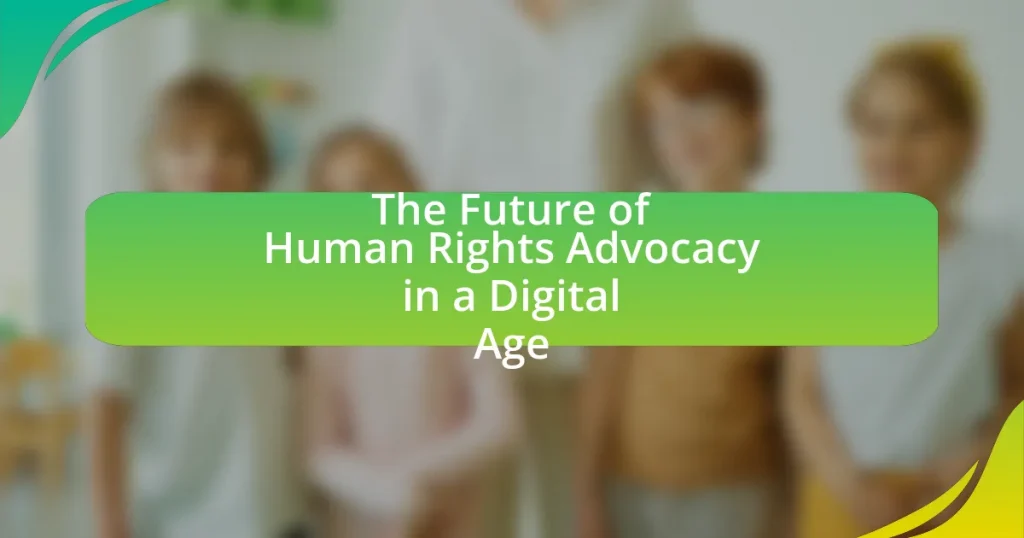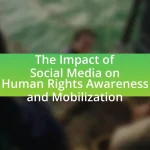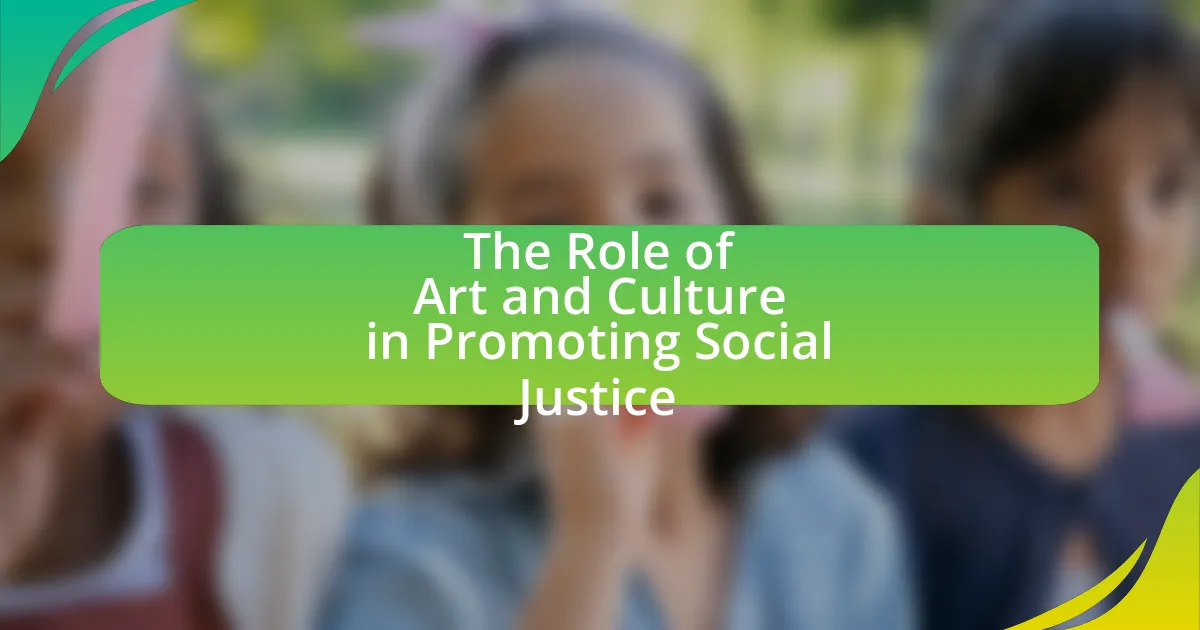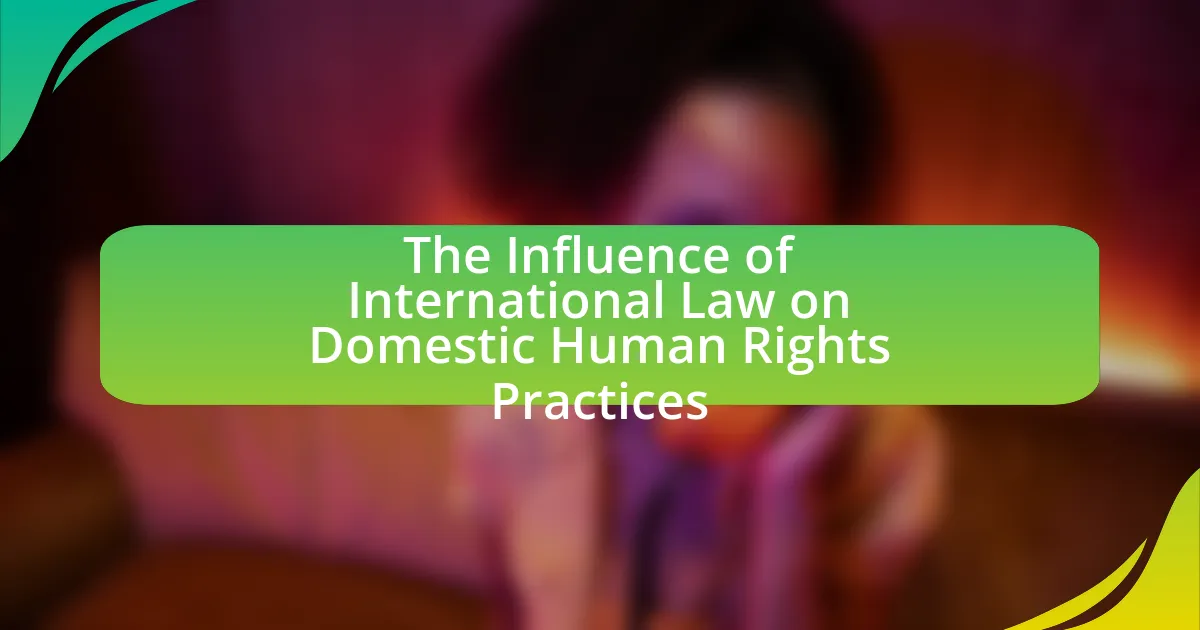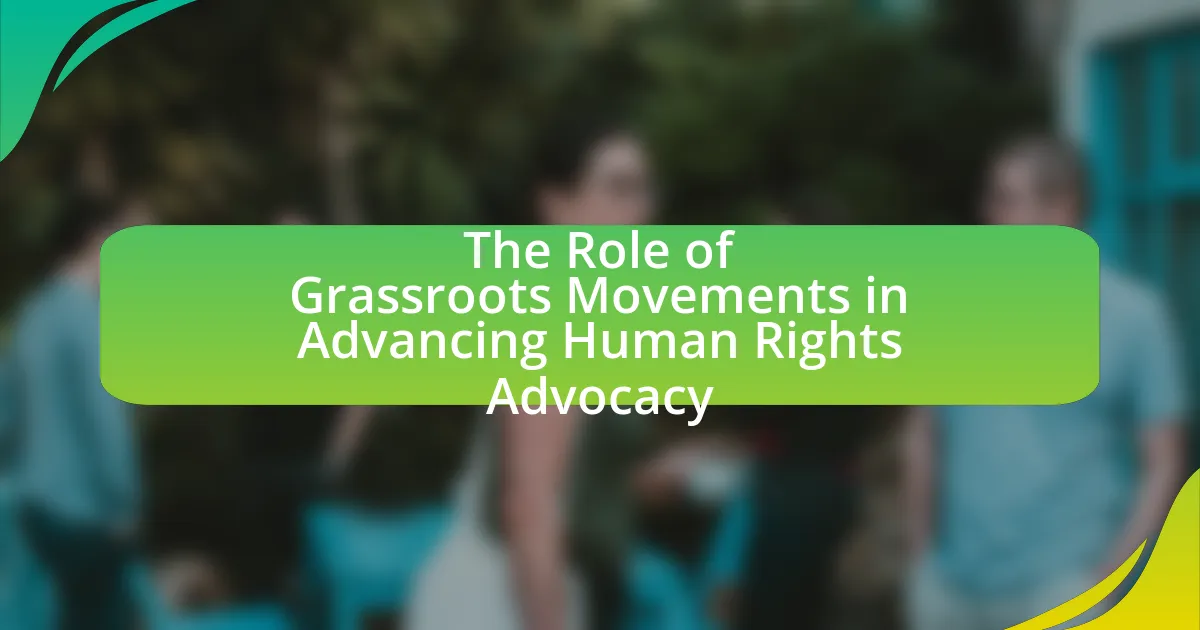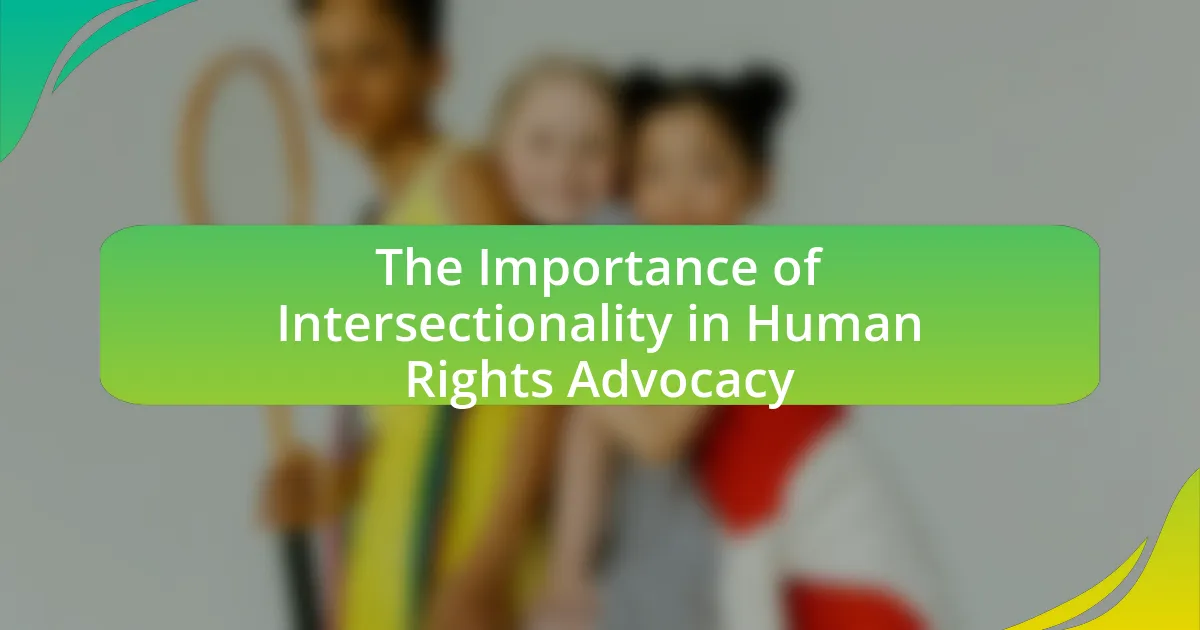The article examines the future of human rights advocacy in the context of digital advancements, highlighting how technology enhances accessibility, global reach, and mobilization efforts. It discusses the transformative role of digital platforms, such as social media, in raising awareness and organizing campaigns, exemplified by movements like #MeToo and Black Lives Matter. Additionally, the article addresses the challenges faced by advocates, including misinformation, surveillance, and the digital divide, while emphasizing the importance of digital security and ethical considerations in advocacy efforts. It concludes by exploring innovative strategies and best practices that can strengthen digital human rights campaigns.
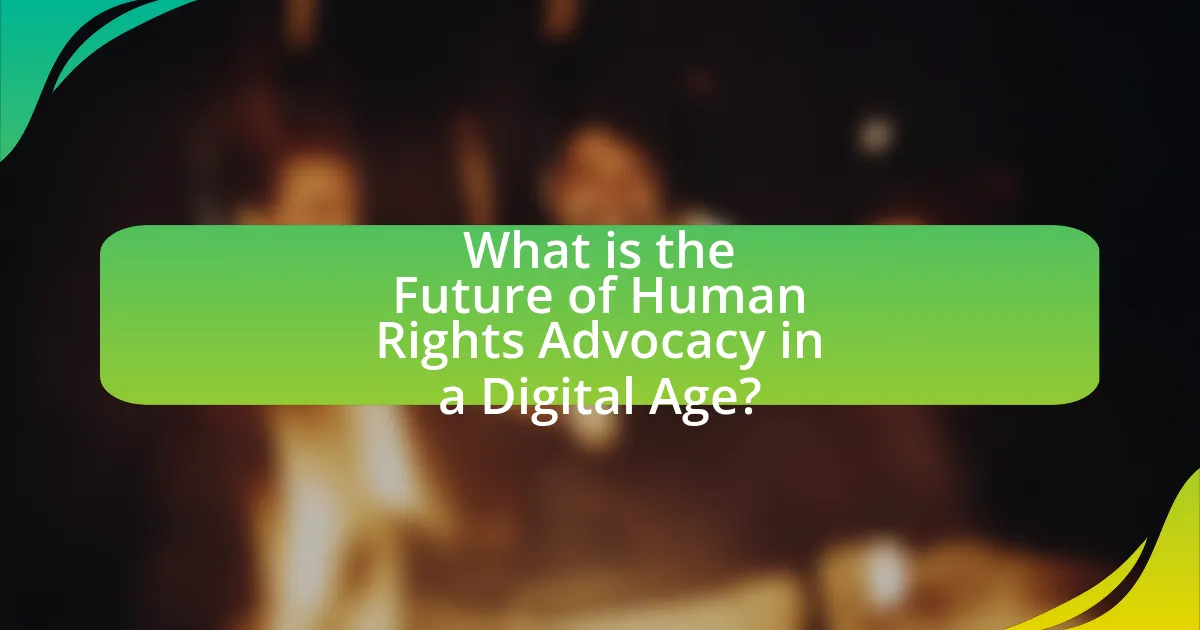
What is the Future of Human Rights Advocacy in a Digital Age?
The future of human rights advocacy in a digital age is characterized by increased accessibility, global reach, and the use of technology for mobilization and awareness. Digital platforms enable activists to disseminate information rapidly, engage with a wider audience, and organize campaigns effectively. For instance, social media has played a pivotal role in movements like #MeToo and Black Lives Matter, demonstrating how online tools can amplify voices and foster solidarity across borders. Furthermore, data analytics and artificial intelligence are being utilized to monitor human rights abuses and inform advocacy strategies, enhancing the ability to respond to violations in real-time. As technology continues to evolve, it will shape the methods and effectiveness of human rights advocacy, making it more dynamic and interconnected.
How is technology reshaping human rights advocacy?
Technology is reshaping human rights advocacy by enhancing communication, increasing access to information, and enabling real-time documentation of human rights violations. Digital platforms allow activists to mobilize support quickly and effectively, as seen in movements like the Arab Spring, where social media played a crucial role in organizing protests and raising awareness globally. Furthermore, tools such as satellite imagery and mobile applications facilitate the monitoring of human rights abuses, providing concrete evidence that can be used in legal proceedings and advocacy efforts. For instance, organizations like Human Rights Watch utilize technology to gather and disseminate data on violations, thereby strengthening their advocacy campaigns and influencing policy changes.
What digital tools are being utilized in human rights campaigns?
Digital tools utilized in human rights campaigns include social media platforms, mobile applications, data visualization software, and online petitioning sites. Social media platforms like Twitter and Facebook enable rapid dissemination of information and mobilization of supporters, while mobile applications facilitate real-time reporting of human rights abuses. Data visualization software, such as Tableau, helps in presenting complex data in an accessible manner, making it easier to communicate issues. Online petitioning sites like Change.org allow individuals to advocate for specific causes and gather support efficiently. These tools enhance engagement, awareness, and advocacy efforts in the digital age.
How do social media platforms influence public awareness of human rights issues?
Social media platforms significantly enhance public awareness of human rights issues by facilitating rapid information dissemination and fostering global conversations. These platforms allow users to share real-time updates, personal stories, and multimedia content related to human rights violations, which can reach millions instantly. For instance, the #BlackLivesMatter movement gained international traction through Twitter and Instagram, mobilizing support and raising awareness about systemic racism and police brutality. Research indicates that social media campaigns can lead to increased public engagement and advocacy, as seen in the 2011 Arab Spring, where platforms like Facebook and Twitter were instrumental in organizing protests and spreading awareness about human rights abuses.
Why is digital advocacy important for human rights?
Digital advocacy is important for human rights because it amplifies marginalized voices and facilitates global awareness and mobilization. The internet allows activists to share information rapidly, reaching a wider audience than traditional methods. For instance, social media campaigns like #BlackLivesMatter have mobilized millions worldwide, highlighting systemic racism and prompting policy discussions. Additionally, digital tools enable real-time reporting of human rights abuses, as seen in the documentation of events during the Arab Spring, which garnered international attention and support. This interconnectedness fosters solidarity and pressure on governments to uphold human rights standards.
What advantages does digital advocacy offer over traditional methods?
Digital advocacy offers greater reach, cost-effectiveness, and real-time engagement compared to traditional methods. It allows organizations to connect with a global audience instantly through social media platforms, email campaigns, and online petitions, significantly expanding their influence. For instance, a study by the Pew Research Center found that 69% of adults in the U.S. use social media, providing a vast platform for advocacy messages. Additionally, digital advocacy typically incurs lower costs than traditional methods like print advertising or in-person events, enabling organizations to allocate resources more efficiently. Real-time engagement through digital channels allows for immediate feedback and interaction, fostering a more dynamic relationship between advocates and their audience.
How does digital advocacy enhance global reach and engagement?
Digital advocacy enhances global reach and engagement by utilizing online platforms to mobilize support and disseminate information rapidly across geographical boundaries. This approach allows organizations to connect with diverse audiences, leveraging social media, websites, and email campaigns to raise awareness and foster community involvement. For instance, the #MeToo movement gained international traction through digital platforms, demonstrating how online advocacy can unite individuals worldwide around a common cause. Additionally, studies show that digital campaigns can reach millions in a matter of hours, significantly amplifying the impact of advocacy efforts compared to traditional methods.
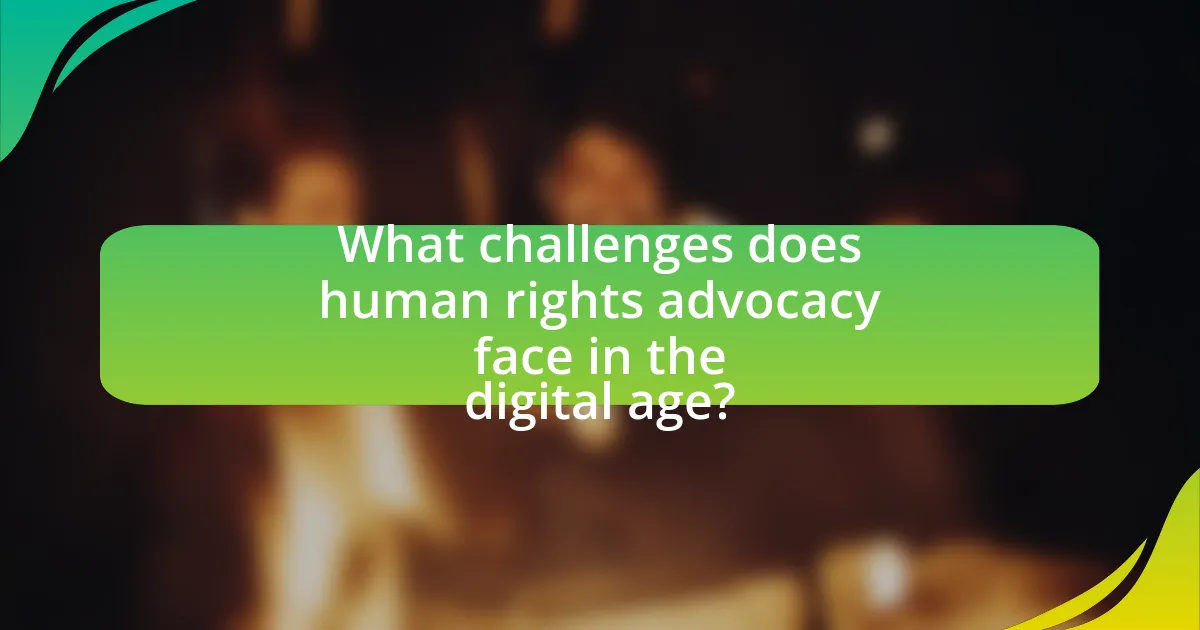
What challenges does human rights advocacy face in the digital age?
Human rights advocacy faces significant challenges in the digital age, primarily due to issues of misinformation, surveillance, and digital divide. Misinformation can undermine advocacy efforts by spreading false narratives, making it difficult for organizations to convey accurate information about human rights violations. Surveillance technologies, employed by governments and corporations, can threaten the privacy and safety of activists, leading to self-censorship and reduced effectiveness in advocacy. Additionally, the digital divide creates disparities in access to technology and information, limiting the ability of marginalized communities to engage in advocacy efforts. According to a report by the United Nations, over 3 billion people remain offline, which exacerbates inequalities in human rights advocacy.
How do online threats impact human rights defenders?
Online threats significantly impact human rights defenders by compromising their safety, silencing their voices, and hindering their advocacy efforts. These threats often manifest as cyberbullying, doxxing, and targeted harassment, which can lead to psychological distress and a chilling effect on their activism. For instance, a report by the International Federation for Human Rights indicates that 70% of human rights defenders have faced online threats, which can deter them from speaking out or sharing critical information. This environment of fear not only affects individual defenders but also undermines the broader human rights movement by limiting the dissemination of vital information and reducing public engagement.
What are the risks of surveillance and censorship for activists?
Surveillance and censorship pose significant risks for activists by compromising their safety, limiting their freedom of expression, and hindering their ability to organize effectively. Activists often face threats of arrest, harassment, or violence as a result of being monitored, which can deter them from speaking out or participating in protests. For instance, the 2011 Arab Spring highlighted how governments used surveillance technologies to track and suppress dissent, leading to arrests and violence against activists. Furthermore, censorship can restrict access to information, making it difficult for activists to mobilize support or share their messages, as seen in countries like China, where the Great Firewall limits online discourse. These risks not only endanger individual activists but also undermine broader movements for social change and human rights.
How can digital security measures protect human rights advocates?
Digital security measures protect human rights advocates by safeguarding their communications and sensitive information from surveillance and cyber threats. These measures include encryption, secure messaging apps, and virtual private networks (VPNs), which help ensure that advocates can communicate without fear of interception. For instance, the use of end-to-end encryption in messaging applications like Signal has been shown to significantly reduce the risk of unauthorized access to conversations, thereby enhancing the safety of human rights defenders. Additionally, implementing strong password policies and two-factor authentication can further protect their online accounts from hacking attempts, which are increasingly common in environments hostile to human rights work.
What ethical dilemmas arise from digital human rights advocacy?
Digital human rights advocacy presents several ethical dilemmas, primarily concerning privacy, data security, and the potential for misuse of technology. Advocates often rely on digital platforms to mobilize support and disseminate information, which can inadvertently expose sensitive data about individuals and communities. For instance, the use of social media for activism can lead to surveillance and targeting by oppressive regimes, as seen in countries like Egypt during the Arab Spring, where activists faced severe repercussions for their online activities. Additionally, the reliance on technology raises questions about accessibility and equity, as marginalized groups may lack the resources or skills to engage effectively in digital advocacy. These dilemmas highlight the need for careful consideration of the implications of digital tools in promoting human rights.
How do issues of privacy and data protection affect advocacy efforts?
Issues of privacy and data protection significantly hinder advocacy efforts by limiting the ability to communicate securely and gather support. Advocates often rely on personal data to mobilize communities and raise awareness, but stringent data protection regulations can restrict access to this information, making it challenging to tailor campaigns effectively. For instance, the General Data Protection Regulation (GDPR) in Europe imposes strict guidelines on data collection and processing, which can deter organizations from engaging in outreach activities due to fears of non-compliance and potential penalties. Furthermore, concerns over surveillance and data breaches can lead to self-censorship among advocates, reducing their willingness to speak out on sensitive issues. This creates an environment where advocacy is stifled, ultimately undermining efforts to promote human rights in the digital age.
What responsibilities do organizations have in the digital space?
Organizations have the responsibility to protect user data and privacy in the digital space. This includes implementing robust cybersecurity measures to prevent data breaches, ensuring compliance with regulations such as the General Data Protection Regulation (GDPR), and being transparent about data collection practices. For instance, a 2021 report by the International Association of Privacy Professionals highlighted that 79% of consumers are concerned about how their data is used, emphasizing the need for organizations to prioritize ethical data management. Additionally, organizations must combat misinformation and promote digital literacy, as misinformation can undermine public trust and human rights advocacy efforts. The Pew Research Center found that 64% of Americans believe that misinformation has a significant impact on their lives, underscoring the importance of responsible communication in the digital realm.
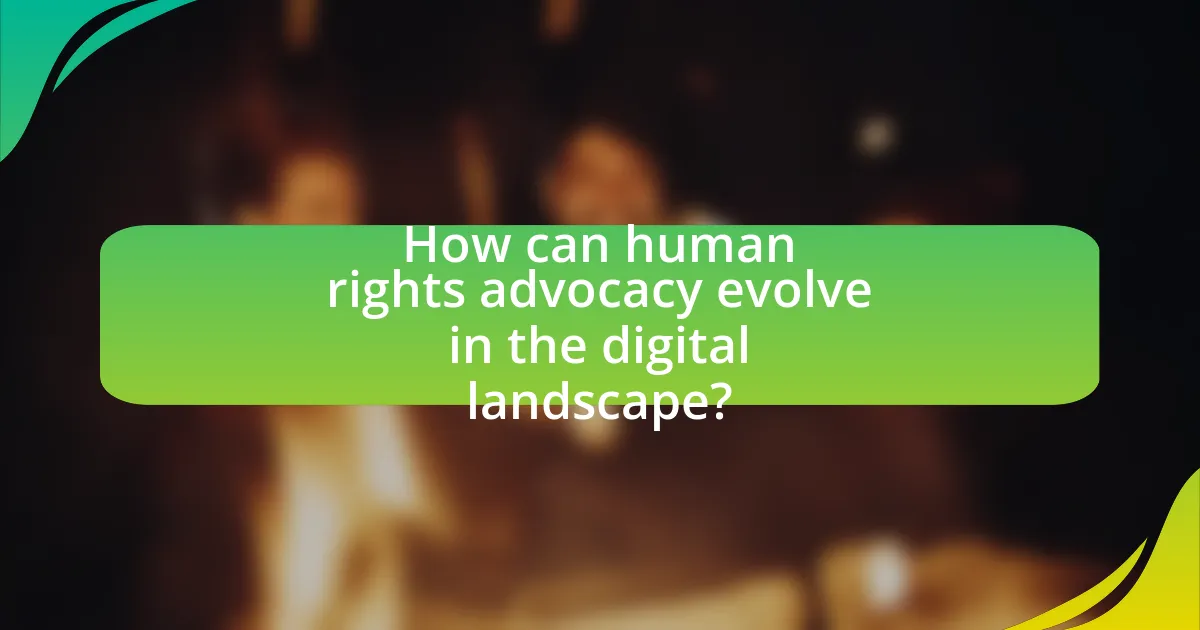
How can human rights advocacy evolve in the digital landscape?
Human rights advocacy can evolve in the digital landscape by leveraging technology to enhance outreach, mobilization, and awareness. Digital platforms enable advocates to disseminate information rapidly, engage with a global audience, and organize campaigns more effectively. For instance, social media has been instrumental in movements like #MeToo and Black Lives Matter, demonstrating how digital tools can amplify voices and foster community support. Additionally, data analytics can help identify human rights violations in real-time, allowing for timely interventions. The use of blockchain technology can also provide transparency in funding and resource allocation for human rights initiatives, ensuring accountability. These advancements illustrate that the integration of digital tools is essential for modernizing human rights advocacy and addressing contemporary challenges.
What innovative strategies can enhance digital advocacy?
Innovative strategies that can enhance digital advocacy include leveraging data analytics, utilizing social media storytelling, and implementing interactive digital platforms. Data analytics allows organizations to identify trends and target specific demographics effectively, increasing engagement and impact. Social media storytelling fosters emotional connections, making advocacy messages more relatable and shareable, which can amplify reach. Interactive digital platforms, such as webinars and virtual town halls, facilitate real-time engagement and feedback, creating a more participatory advocacy environment. These strategies are supported by research indicating that campaigns utilizing data-driven approaches see a 30% increase in engagement rates, while storytelling can boost message retention by up to 22 times compared to traditional methods.
How can storytelling and multimedia be leveraged for impact?
Storytelling and multimedia can be leveraged for impact by creating emotional connections and enhancing engagement with audiences. Effective narratives combined with visual elements, such as videos and infographics, can convey complex human rights issues in a relatable manner, making them more accessible. For instance, research by the Stanford Social Innovation Review indicates that stories can increase empathy and motivate action, as they allow individuals to see the human side of abstract issues. Additionally, multimedia platforms enable wider dissemination of these stories, reaching diverse audiences and amplifying advocacy efforts.
What role do partnerships play in strengthening digital campaigns?
Partnerships play a crucial role in strengthening digital campaigns by enhancing resource sharing, expanding audience reach, and leveraging diverse expertise. Collaborating organizations can pool their financial, technological, and human resources, which increases the overall effectiveness of the campaign. For instance, a study by the Stanford Social Innovation Review highlights that partnerships can lead to a 30% increase in campaign engagement when organizations combine their networks and resources. This collaborative approach not only amplifies the message but also fosters innovation through the integration of different perspectives and skills, ultimately leading to more impactful advocacy in the digital landscape.
What best practices should advocates follow in the digital age?
Advocates in the digital age should prioritize transparency, engagement, and data security. Transparency involves openly sharing information about advocacy efforts and decision-making processes, which builds trust with stakeholders. Engagement requires utilizing social media and digital platforms to connect with diverse audiences, fostering community involvement and mobilization. Data security is crucial, as advocates must protect sensitive information and ensure the privacy of individuals involved in their campaigns. According to a 2021 report by the International Federation for Human Rights, organizations that implemented these best practices saw a 30% increase in public support and participation in their initiatives.
How can advocates effectively engage with their audience online?
Advocates can effectively engage with their audience online by utilizing targeted social media strategies, creating compelling content, and fostering interactive communication. Research indicates that 73% of marketers believe that their efforts through social media marketing have been “somewhat effective” or “very effective” for their business (Buffer, 2021). By leveraging platforms like Twitter, Facebook, and Instagram, advocates can reach diverse demographics and tailor their messages to resonate with specific audiences. Engaging content, such as videos, infographics, and live Q&A sessions, can enhance audience interaction and retention. Additionally, responding to comments and messages promptly fosters a sense of community and trust, which is crucial for effective advocacy in the digital age.
What are the key considerations for maintaining credibility in digital advocacy?
Key considerations for maintaining credibility in digital advocacy include transparency, accuracy, and engagement with the audience. Transparency involves openly sharing sources and methodologies, which builds trust; for instance, organizations like Amnesty International provide detailed reports that cite their data sources. Accuracy is crucial, as misinformation can undermine credibility; a study by the Pew Research Center found that 64% of Americans believe misinformation is a major problem in digital communication. Lastly, engaging with the audience through responsive communication fosters a sense of community and trust, as seen in successful campaigns by organizations that actively respond to feedback and questions.
